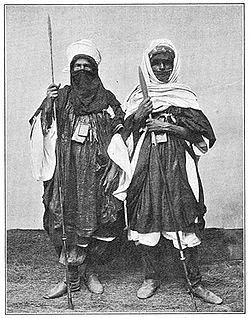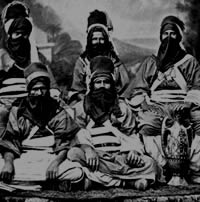lifestyle and begins to make some links between Tauregs and
Turks.//
The Great Sahara Desert traveler Sami Bey was kind enough to provide Muhit with the
portion of his travel log related to the Tauregs. In this publication, there will be some
similarities with the lives of Taureg children living in the African desert and the Turks of Asia.
Camels
The chiefs of free men tribes have some rare camels, which are not multiplied to
prevent them from being passed along to others. The offspring of these camels
are killed and only the number of camels needed are allowed to live. Saddled
camels stand in wait in front of the tent of each free men tribe chief in the event
,of a raid, so the chief can escape immediately. These camels are nourished with
camel milk that concubines bring by the pailful and pour into a hole lined with ox
skin for the camels to drink from. Camels far from pastures are nourished with
milk, dates or clover. These animals can go without food and water for five days
in summer and ten days in winter. I once left Gat with a friend named Shaikh
Kınnı and we rode our camels for 10 days in the desert, yet the camels never lost
their stride. The Tauregs gather up the dried seeds of plants and flowers that they
find in a valley, put them in a large sheepskin pouch and spread them in another
valley 5 or 10 days distant. That is why the same plants, flowers and trees are
encountered in almost every valley of the Great Sahara Desert.
When the Tauregs approach a well, a few of them will run ahead to the well to
check the traces there, to determine whether camels and men from their tribe have
been to this well recently. The Tauregs are very astute at reading traces. In the
Fezzan region everyone buries dates, wheat and other grains in the sand, leaving
a mark of some sort that is considered a seal. No one is permitted to approach
such a spot because the mark is immediately recognized and the culprit would
be caught.
Two Examples

A store in Murzuk was robbed. A Taureg scout was brought in and he found some
traces in the store. He said that the trail led to the barracks so they dumped sand
at the door of the barracks. Each soldier passed through the sand as the Taureg
scout watched. When the scout saw the print he had memorized he grabbed the
soldier by the arm, thus identifying the owner of the print left in the store. The
soldier confessed and the goods he had taken were put in the square. This soldier
was a local black.
When war with Italy was declared (late 1911) I received the news while travelling
between Gat and Gıdamıs. I returned to Şatı district and a few days later Sultan
Amut, the chief of the Eymenen tribe, came and found me. He said “I was going
from Gıdamıs to Gat and my slave saw the print of Ferhan, Recep Paşa’s old camel
that you ride. My slave said that you headed east. Ten years ago this slave looked
after Ferhan. So we followed your trail to here.”
Tuareg Spears

The Tauregs most trusted weapon is their spear. At a very young age they begin
spear training. I witnessed a Tevarik spear competition in the Tasili Mountains.
They nailed an approximately one square-meter hippopotamus hide to a cypress
tree and threw spears at it from one hundred paces. I was amazed not just that
they hit the hide but the depth of the spears’ penetration, as well. One of the
Taureg’s spears penetrated 11 centimeters into the tree, testifying to the strength
of their arms. For a Taureg, throwing a spear to down a fleeing camel is child’s
play. They have great hunts with their spears, tracking the prey on their camels
for kilometers. As the target animal slows from exhaustion the Tauregs catch up
on their camels and kill the prey with their spears.
Wells
There are artesian wells in the places Tauregs have lived since ancient times.
The wells begin on the mountain slopes and follow a straight line, with each well
20-30 meters distant from another. The wells are linked by a tunnel and, because
of the sloping ground, the first well runs into the second and so on, resulting in a
water flow like that of a stream. I have seen these wells myself in Turkistan,
Horasan, Tehran, Tebriz, Van, Kerkuk and Erbil. I learned that there are such wells
in Afghanistan, too. The practical engineers who have figured them out are all
Turks. In Nişabur I saw water brought in from afar and the water turned mills,
irrigated land and, in some places, was drinkable. The tops of some of these wells
are left open to take advantage of air pressure to make the water flow.
In north Africa, the ruins of these tunnels are seen in Bengazi, Tunus and Morocco.
They are encountered, as well, in Zelle, Hun (in Sökne district) and various parts
of Fezzan, particularly around the village of Cerma in Vadi-i Garbî, where the
“Garamant” , an ancient branch of the Tauregs, lived. The places where these wells
went are now covered with sand. There is no doubt that the Tauregs’ settlements
in Fezzan are below these sand hills, since this is where to water flowed to. These
wells are quite deep, some of them more than 100 meters. In the same way that the
water penetrated and carved out rock, so too are there walls that have been built by
the flow. On these walls there are Tifinah writings. These days the Arabs there use
the wells as simple water wells. The water is always there and never runs out. The
Arabs call them fıkarat, which has a meaning similar to ‘backbone’. The Turks of
Iran and Van call them “kanat” or “geriz”. The Tauregs are very knowledgeable
about well-digging and wall-building. The don’t fear going deep into the Great
Sahara, where they have dug numerous wells in the vast expanse of the desert,
finding a place to live for themselves and preserving their independence. This is
how they penetrated into the south. M.E.F. Gantier was amazed when he saw the
wells at Tuvat, saying “in the entire world, wells like this are found only in Asia
Minor (Anatolia)” (La Conquete du Sahara, page 206, Librarie Armand Colin,
Paris). He added that these wells in Tuvat take up a 2,000 kilometer area.
M. Dear has written that these artesian wells were found in Morocco in pre-
historical times and that “Alyonpodore” spoke about them in the 6th century and
İbn Haldun in the 14th century. The engineer Fresnel saw these amazing wells in
Barka and Libi and wrote that they dated from the time of the Pharoahs. Volney
and Lamartin have also written that there are such wells in the Tir ruins.
The Name of the Tauregs – Historical Information

The Tamahous of the 12th line of the Pharoahs who lived in the year 1000 B.C.,
are mentioned. There are four types depicted in the pictures carved into the
Pharoahs’ stones. In the middle are the swarthy people (Egyptians), on the right
the yellowish people (Arabs), in the back the blacks, and on the left the blue-eyed
(whites) wearing leather clothes and fur caps (La Foret Vierge et la Sahara, Par
E. Desor, pages 99, 147). These whites are called Tamahous. The Tauregs call
themselves Temahag or Temachek. There is a striking resemblance between these
words. Despite the fact that the pronunciation of each of the separate Tevarik
tribes is different, their dictionary and writing is the same.
According to Herodot, the Berbers and the Tauregs are from the same family, both
being members of the Libiyens and their forebears being the Tamahous. Since it
can be seen that these wells are found in Amond, Barka, Libi, Fezzan, all of North
Africa and on the fringes of the Great Sahara Desert, and that they all completely
resemble each other, having been made by the same people, there can be no doubt
that the wells were made by members of the Tamahous. These wells are the same
as those that are found in the Turkic world. Some of the Tauregs say that they came
from Asia. Kınna, a dear friend of mine in Fezzan, who is the chief of the Tinilküm
tribe and who once kidnapped me, told me that the Tauregs are Turks, with some of
them having come from the north, from Spain, and others coming to Africa through
Egypt. In fact, he used to tell me that they had created a great government in their
time and that their history books, written on skins, were called “Kefedere”.
Dr. A. Richer reported that another ascetic/scribe echoed these words of Shaikh Kınnı
in a book he wrote in the south for Cortier in 1901 about the Tevarik. Dr. Richer
stated that the Tevarik came from Asia Minor to Syria and from there to Africa
(Revue du Monde Musulman, page 143. 1918.) Captain Clapperton quoted some
portions of a hand-written work entitled Enfake’l-Meysour fî-Tariki Belade’t-Takrour,
written by Mehmed Bello, the Sultan of the Houssas in inner Africa, and the section
about the Tevarik is given as follows:
“ These Tauregs are from the same race as the Berbers. They spread to Africa in the
invasion period. The Berbers are from the Ham family. They claim that a portion of
them are from the Yafes line and the other portion is from the line of Ye’cüc Me’cüc,
who was imprisoned by Alexander the Great. However, in those time there was a
tribe of theirs in Kırvan and they mixed with the Turks and Tatars there.”

//END OF PART III//

Hiç yorum yok:
Yorum Gönder